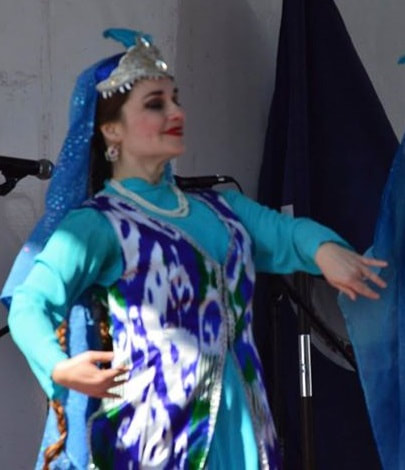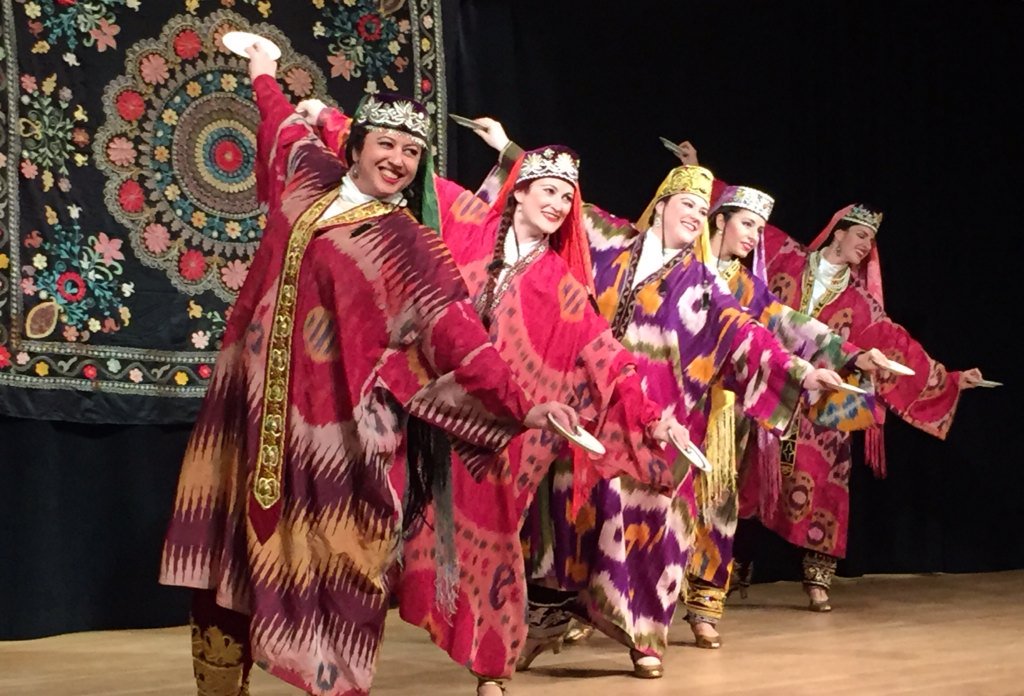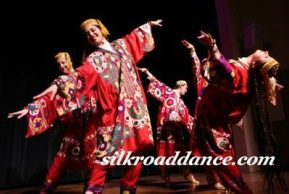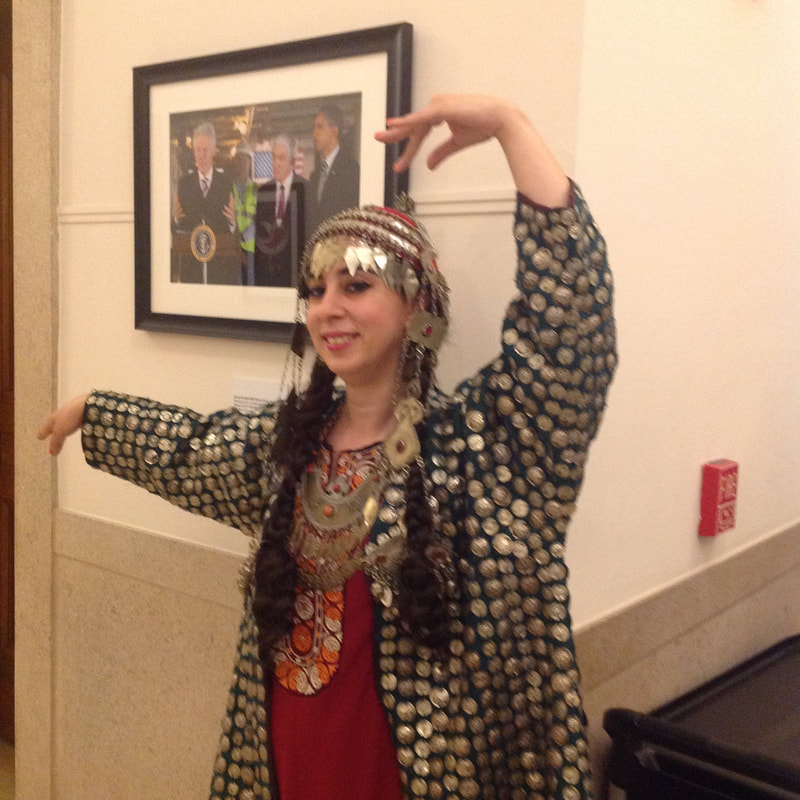Silk Road Dance Company ®
Central Asian
Cry of the Heart
Inspired by the Sufi ritual of zikr, or remembrance, this choreography draws on gestures from many different cultures of the East which reflect the heart's innermost yearnings. It also depicts the plight of millions of women who, unseen, have no political voice. Choreography: Laurel Victoria Gray Costume design: Laurel Victoria Gray, Elaine Lamirande and Cindy Connelly Ryan Music: Steven Flynn |
|
|
|
Darya Toshkin
''The river is flooding,'' says the singer, referring to his overflowing emotions. He praises the beauty of his beloved and imagines her in a colorful silk dress. The style of the piece is in the lyrical Ferghana Uzbek genre. Choreography: Laurel Victoria Gray |
Everyone Has a Beloved
|
|
|
|
Guldasta
A modern classic in the Uzbek dance repertoire, Guldasta means ''a bouquet of flowers.'' It typifies the demanding Bukharan style with acrobatic elements and dazzling spins. This choreography is part of Silk Road Dance Company's Legacy Repertoire. Choreography: Peoples’ Artist of Uzbekistan, Isaqar Aqilov, Costume design: Laurel Victoria Gray |
Katta OyinThis famous classical dance of Samarkand was included in the repertoire of the legendary Bakhor Ensemble of Uzbekistan. It is performed solely to complex dance rhythms. Katta Oyin means “grand dance.” This choreography is part of Silk Road Dance Company's Legacy Repertoire. Choreography: Muharram Turganbaev |
|
|
Kungil TaronasiThe dancers of the region of what is today Uzbekistan were once so admired that the Chinese Emperor brought them to his court. This admired dance tradition revived in the 20th century with the founding of the celebrated Bakhor Ensemble. A classic piece from their repertoire, this dance combines lyricism with the technically demanding spins for which Uzbek dance is famous. Choreography: People's Artist of Uzbekistan, Mukarram Turganbaeyeva Costume Design based on Bakhor Ensemble. |
Munojat
Munojat is a lament to God. It is also the title of poem by the 15th century poet, Alisher Navoi. The dance itself, set to classical Uzbek music, can be interpreted on two levels. One is the story of a young woman who is forbidden to marry the man she loves. She prays for deliverance form this situation and, in her despair, hallucinates, thinking she sees her beloved before her. She dances joyously only to realize that the apparition is an illusion. On a spiritual plane, Munadzhat is an allegory symbolizing the soul’s yearning for union with the Divine. Choreography: Peoples’ Artist of Uzbekistan, Isaqar Aqilov |
Pilla
This charming piece, performed to the rhythm of the Uzbek frame drum (doire), depicts the work of women who create silk. First, they feed the silkworms tender mulberry leaves. Later they spin thread, weave fabric, and embroider scarves. Choreography: Tamara Khanum, People’s Artist of the USSR, and Ustad Olim. |
|
|
Samarkand UshoriThis piece features the elegant, regal poses which typify classical Uzbek dance. The music is a setting for Farsi poetry by Zebunnisa, a grand-daughter of Tamerlane, and is performed by Zuleikho Baikhonova. This dance was gifted to the Silk Road Dance Company by People's Artist of Uzbekistan, Kizlarkhon Dustmukhamedova, who is the Artistic Director of Ensemble Munojat. Choreography: Kunduz Mukarimova, People’s Artist of Uzbekistan |
Tulips of Tajikistan
Even as winter approaches, the promise of rebirth and renewal awaits in the spring. In Tajikistan, wild tulips cover the hillsides in spring and the word ''lola,'' meaning tulip, is a popular girl's name. This dance was inspired by Tajik dancers who worked with Silk Road Dance Company in Samarkand in 2005. We offer it as a joyous gift of hope. Photo courtesy of Philadelphia Museum of Art. Choreography and costumes: Laurel Victoria Gray |
Uighur Dance Gulyarxon

This piece embodies the vigor and delicacy of Uyghur dance. The Uyghurs are a Turkic people with a rich, ancient culture; they were a force to be reckoned with in the days of the ancient Silk Road. Uyghurs are currently found throughout Western China, Mongolia, and Central Asia. Wang Yen De, the Chinese ambassador in the Karakhoja Uyghur Kingdom in 981-984, praised their civilization and the beauty of their arts, crafts, and architecture.
Choreography: Laurel Victoria Gray
Kush Depti: Turkmen Dance
The Turkmen people maintain a proud nomadic heritage and a superior repution as horse breeders and artisans. Their carpets, metalwork, and embroidered garments have long been prized by collectors world-wide. Here two groups of girls meet and show off their weaving skills, lovely long braids, and glittering jewlery; many of the dance movements are drawn from daily gestures of nomadic life, including playing music, weaving, spinning yarn, and weaving. |
Silk Road Dance Company ® is a Registered Trademark of the Silk Road Dance Company,
A Maryland nonprofit corporation and a 501(c)3 exempt tax non-profit organization.
Silk Road Dance Company P.O. Box 11346 Takoma Park, MD 20913 • 301-585-1105 • [email protected]
The contents of this website, including all text and images, are protected and may not be used without the express written permission of Silk Road Dance Company®.
Copyright 2013, Silk Road Dance Company ®. All rights reserved.
A Maryland nonprofit corporation and a 501(c)3 exempt tax non-profit organization.
Silk Road Dance Company P.O. Box 11346 Takoma Park, MD 20913 • 301-585-1105 • [email protected]
The contents of this website, including all text and images, are protected and may not be used without the express written permission of Silk Road Dance Company®.
Copyright 2013, Silk Road Dance Company ®. All rights reserved.











